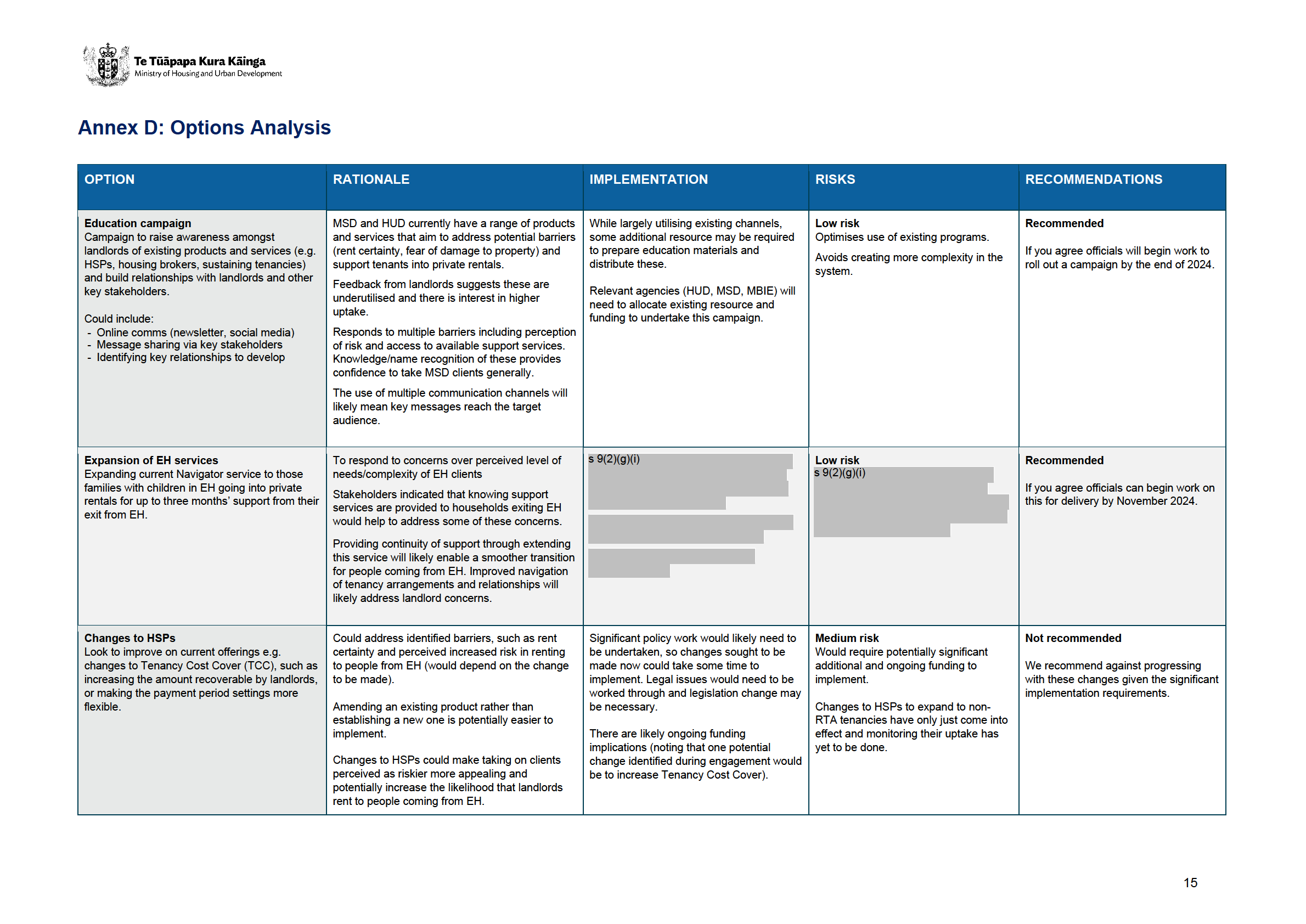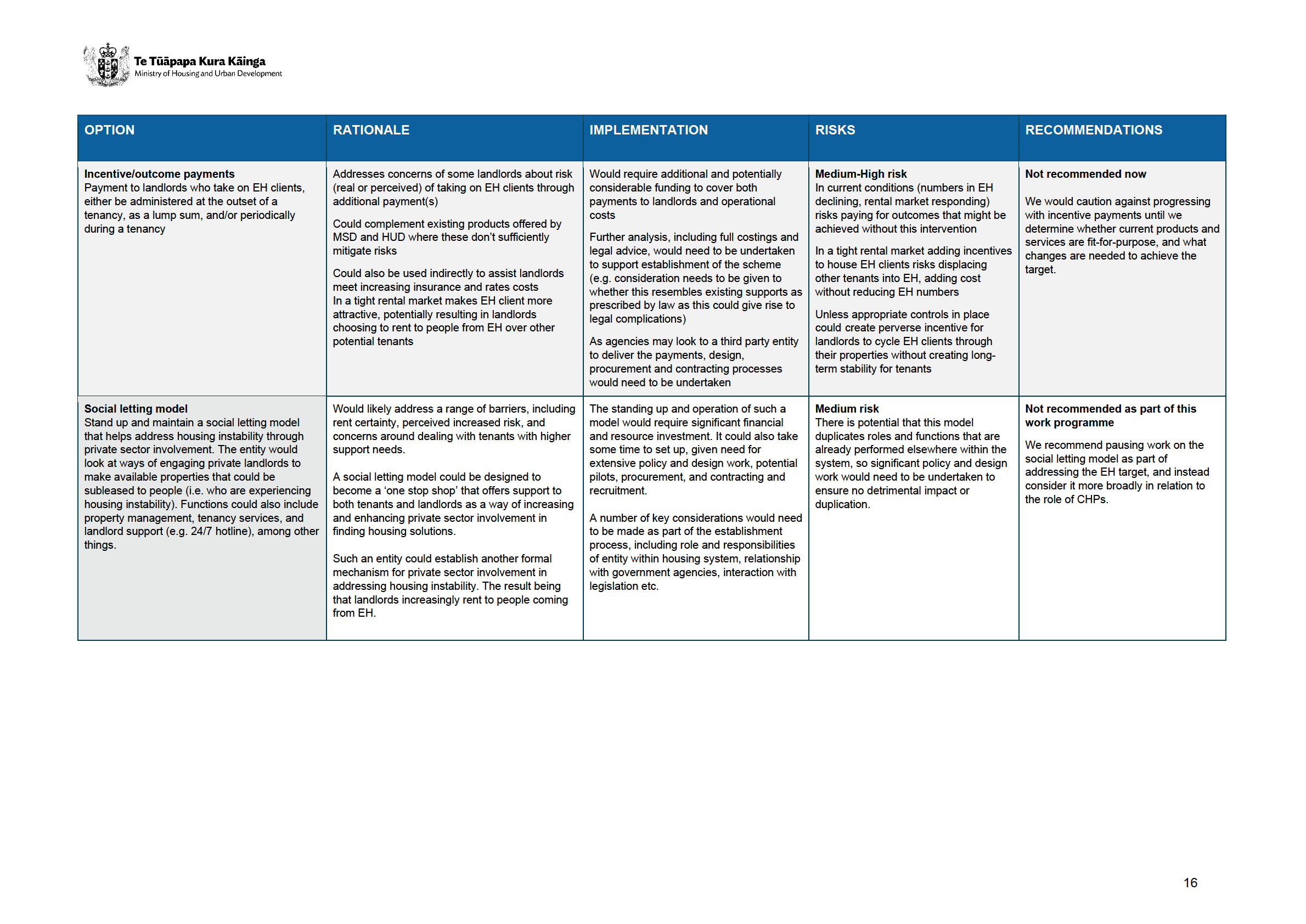 Briefing
FURTHER ADVICE ON OPTIONS TO INCENTIVISE LANDLORDS TO RENT TO
EMERGENCY HOUSING CLIENTS
To Minister
Briefing
FURTHER ADVICE ON OPTIONS TO INCENTIVISE LANDLORDS TO RENT TO
EMERGENCY HOUSING CLIENTS
To Minister
Hon Tama Potaka
Portfolio
Associate Minister of
Housing
CC Minister
Hon Chris Bishop
Portfolio
Minister of Housing
CC Minister
Hon Louise Upston
Minister for Social
Development
Date
05/09/2024
Priority
High
Tracking number
HUD2024-005248
ACTION SOUGHT
Action sought
Note this briefing provides you with further information on options
for incentivising private landlords to rent to people from Emergency
Housing.
Agree to the proposed approach and actions to deliver this work
programme.
Deadline
19/09/2024
CONTACT FOR DISCUSSION
Name
Position
Telephone
1st
contact
Jeremy Steele
General Manager, Housing
s 9(2)(a)
Supports and Supply
Laura Mil er
Policy Manager, Responding to s 9(2)(a)
Severe Housing Needs
OTHER AGENCIES CONSULTED
Ministry of Social Development (MSD)
HUD2024-0052481 Further advice on options to incentivise landlords to rent to emergency
housing clients
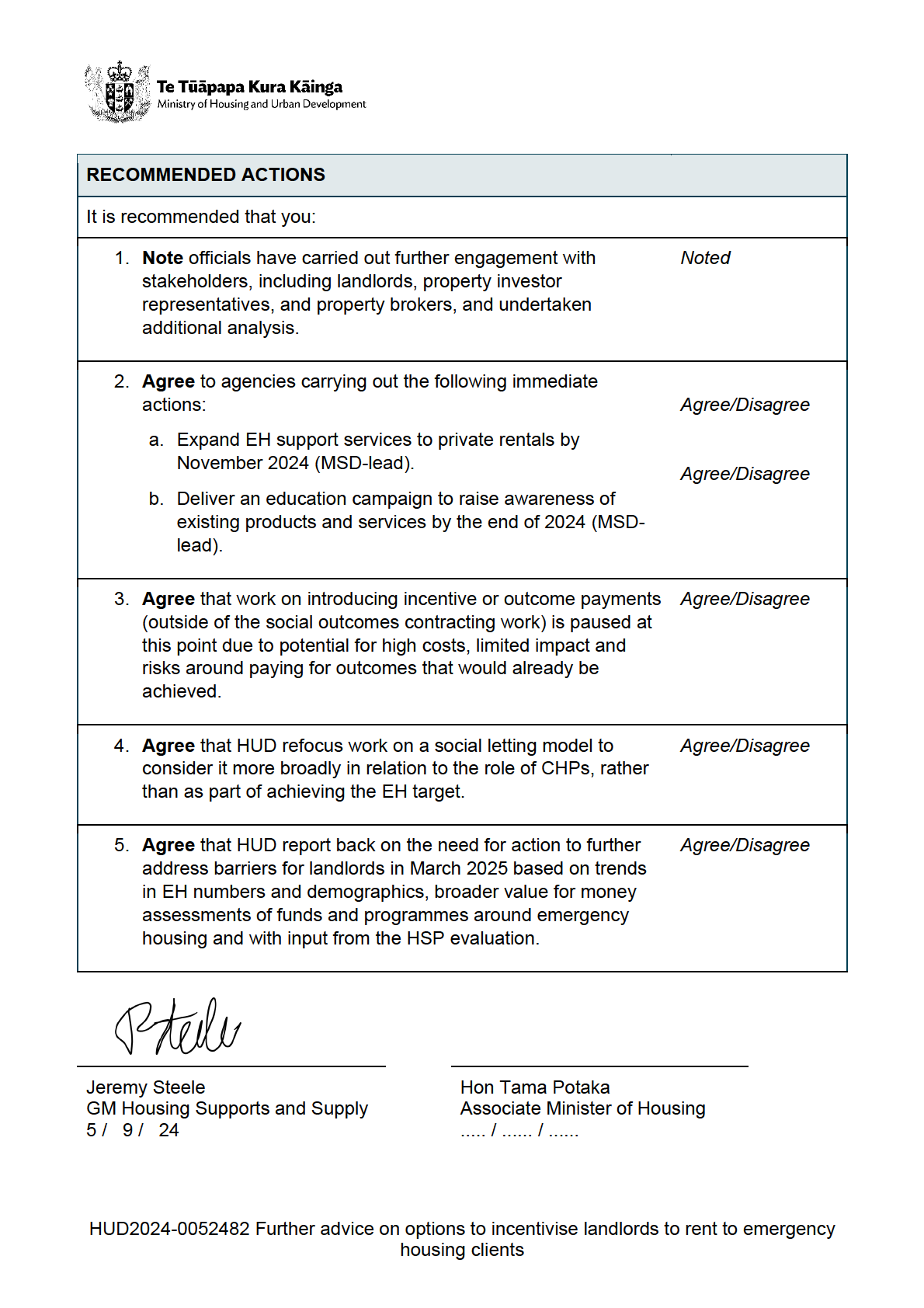
 Purpose
1.
Purpose
1.
The purpose of this paper is to provide further advice on incentivising landlords to rent
to people in Emergency Housing (EH). The paper also provides further information on
the potential of developing a social letting model.
Executive summary
2.
Since we provided initial advice on incentives for landlords in June the number of
households in EH has continued to decline significantly. We have also completed a
second round of engagement with key stakeholders including landlord, property
investor and property broker groups. This engagement along with further analysis of
potential impact, costs, and interaction with existing supports have informed this
advice.
3.
A range of products and services are already available that can assist people to exit
EH into private rentals and retain those tenancies. These products attempt to address
many of the key issues raised by stakeholders (rental certainty, damage mitigation,
and supports for tenants). MSD estimated that $118.5m was spent in 2023/241 on
Housing Support Products, and around $84m funding was provided in Budget 2024 to
continue MSD’s emergency housing support services for two years. Take-up of HSPs
is being evaluated and evaluation is underway of Housing Support Services.
4.
We propose that at this time two specific actions are taken to build on and improve
existing supports to incentivise landlords or address issues they have raised, led by
MSD:
a.
developing and expanding support services to people leaving EH and
moving into private housing. These services can provide crucial assistance as
individuals and families transition to more stable living circumstances. We
anticipate that these changes wil not only go to address landlord concerns
around the risks of renting to people from EH, but also enhance the functionality
of the system and help more people in need.
b.
implementing an education campaign to promote existing products and
services, as knowledge of these was found to be varied during recent sector
engagement. We wil also take the opportunity to further strengthen key
relationships within the system to continue to bridge gaps.
5.
At this point we do not recommend progressing work on incentive or outcome
payments to landlords because of the potential for high costs (for outcomes that may
already be achieved), limited impact, and displacement of other renters.
Stakeholders indicated these payments may have some impact but in isolation were
unlikely to change behaviour significantly. The cohort that these types of payments
1 2024 Budget Economic and Fiscal Update, note, $112.8m of that is recoverable assistance.
HUD2024-0052483 Further advice on options to incentivise landlords to rent to emergency
housing clients

might best work with (families with children in EH in Auckland) has also reduced
significantly.
6.
While there would be benefits to a social letting model this is a significant and
complex piece that could be better progressed as part of work on the broader role of
CHPs.
Background
7.
The Government has committed to reducing the number of households in EH by 75
per cent by 2030 (the EH Target). The EH Delivery Plan sets out the actions being
taken to achieve the target.
8.
The Delivery Plan includes an action to explore options to incentivise landlords to rent
to people coming out of EH. While many tenants go from EH to private rentals it can
be dif icult for them to secure private rentals and maintain them.
9.
We provided you with initial advice on options to incentivise private landlords in late
June (HUD2024-004784). That advice noted that most landlords are trying to generate
cashflow and will favour options with reliable returns and ease of operations. As such,
barriers for landlords to rent to EH clients include concern about potential risks
(damages to property, antisocial behaviour) and high tenant support needs, and a
need for rent certainty. It also noted limited awareness of some existing Ministry of
Social Development (MSD) provided supports and services to address some of the
identified barriers (a full list supports and services is attached at
Annex A).
10.
You directed officials to further develop options to encourage landlords to rent to EH
clients and provide more detailed advice on them.
We have undertaken further engagement with key stakeholders
11.
In July and August, we undertook further engagement with key stakeholders, to test a
range of interventions aimed at addressing the identified barriers to renting to people
in EH. We engaged with the Real Estate Institute of New Zealand, Property Investors
Federation, Auckland Property Investors Association, and Property Brokers to test
interventions related to support and management services, rent certainty, education
and awareness, and funds and incentive payments.
12.
This engagement reinforced an earlier finding that there seems to be limited
awareness amongst private landlords of supports already available to address many of
the barriers they raised. While rent certainty was identified as the key incentive, we
also heard that no single incentive would suffice or suit everyone, but a suite of actions
may function to address barriers.
Annex B includes a summary of other insights.
Who and where would benefit from an incentive approach
13.
If progressing either incentive payments and/or a social letting model, we would
recommend that they are trialed in a location with a relatively stable rental market to
HUD2024-0052484 Further advice on options to incentivise landlords to rent to emergency
housing clients

ensure the introduction of this intervention would not distort the market. Based on
rental markets, Auckland is currently the most appropriate location for a trial.
14.
These interventions would also be best suited to support those with less affordability
issues, and less complex needs. We would undertake more in depth cohort analysis to
specifically target interventions should that approach be pursued in the future.
There are a range of existing products that attempt to address many of the issues
raised by landlords
15.
There are already a range of existing services and programmes designed to support
individuals and families to obtain and retain accommodation in the private market. As
such a key consideration in this advice is how any additional services, supports, or
payments would interact with the existing system and their likely impact on desired
outcomes.
16.
MSD’s Housing Support Programme provides recoverable grants2 for accommodation
related costs to assist eligible applicants to obtain and retain accommodation. Housing
Support Products (HSPs) are a key tool to help people to exit EH, and to enter and
remain in private accommodation. In the 2024 Budget Economic and Fiscal Update,
MSD estimated that $118.5m would be spent on HSPs in the 2023/24 financial year,
with $112.8m of that recoverable assistance. This is on top of other financial
assistance to address ongoing accommodation affordability challenges such as
Accommodation Supplement (AS) and Temporary Additional Support (TAS). HSPs
were extended to non-RTA tenancies on 1 July 2024. Current HSPs which already
provide assurances to landlords include:
a.
Tenancy Cost Cover that provides landlords with assurance the client wil be
able to meet any tenancy related costs over and above the rental bond (up to a
limit) if owed at the end of the tenancy (for RTA accommodation agreements)
b.
Accommodation Security Cover Grant that provides assurance to
accommodation suppliers that the client wil be able to pay any outstanding
costs, up to a limit, at the end of their accommodation agreement (for non-RTA
accommodation agreements)
c.
Accommodation Costs Arrears Grant which is a recoverable payment to cover
rent arrears if a tenancy is at risk (for both RTA and non-RTA agreements).
17.
As part of developing HSPs, MSD has been conducting an evaluation looking at trends
in HSP use and effectiveness (effectiveness is defined as a client leaving and/or
staying out of temporary housing following receipt of an HSP). MSD expect to have
this evaluation completed by February 2025. You wil be provided a copy of this
evaluation.
18.
s 9(2)(j)
2 With the exception of Transition to Alternative Housing Grant, which is non-recoverable.
HUD2024-0052485 Further advice on options to incentivise landlords to rent to emergency
housing clients

s 9(2)(j)
We recommend delivering an education campaign to promote awareness of existing
housing support products and support services, and build relationships with landlords
19.
We recommend steps are taken to further educate landlords about already available
products and build stronger relationships with property investors, rental brokers and
landlords. MSD have confirmed funding and capacity to begin roll this out by the end
of 2024. (
Annex C includes details).
There is also an opportunity to expand MSD’s EH support services to private rentals
20.
A key concern raised by some stakeholders was the perceived level of needs and
complexity of issues that some people exiting EH have. Stakeholders indicated that
knowing support services are provided to households exiting EH would help to
address some of these concerns.
21.
MSD already provides support services to those who need them in EH through
Housing Brokers, Navigators, Ready to Rent programmes and Integrated Services
Case Managers. These supports can help broker the relationship between prospective
tenants and landlords, help navigate a prospective tenant through the renting process
and can help alleviate concerns in that they can ‘vouch’ for potential tenants. The level
of support a household gets wil vary based on their needs and location.
22.
Under the August 2024 changes to EH grant settings MSD can direct people to work
with support services. MSD does not have the same ability to require tenants of public
housing or those in private accommodation to have a support service in place.
23.
However, MSD has built in an allowance to existing Navigator contracts for EH support
services where needed to follow people as they transition into social housing for a
period of time.
24.
MSD could consider expanding this service to those families with children in EH going
into private rentals as part of its existing contracts. This change could be done within
the time limited EH support services funding with existing providers.
25.
s 9(2)(g)(i)
HUD2024-0052486 Further advice on options to incentivise landlords to rent to emergency
housing clients

s 9(2)(g)(i)
26.
MSD propose that this change could be delivered by November 2024, with navigation
support service for up to three months following exit from EH.
27.
HUD’s Sustaining Tenancies programme is open to tenants in private or public
housing and therefore already includes private tenants who have recently left EH.
However, we will explore how the programme can best support this cohort to remain in
their tenancy by addressing any issues that may put this at risk. HUD presently
contracts approximately 2,400 places at an average $5,000 per person.
We do not recommend progressing incentive payments or work on a social letting
model at this time
Incentive/outcome payments
28.
Incentive payments are used to provide landlords additional financial incentive
(beyond regular rental income) to take on clients perceived as being riskier and
mitigate any residual risk (around missed rent etc). They could either be administered
at the outset of a tenancy, and/or periodically during a tenancy, as a lump sum, or
incrementally. Periodic outcome-based payments could be used to ensure a tenancy
is sustained.
29.
These types of payments could complement the existing products offered by MSD and
HUD to mitigate any risks not directly, or fully addressed by existing products (e.g.
meeting insurance and rates costs). Landlords have indicated these would have some
impact, but are unlikely to be sufficient in isolation.
30.
These types of payments carry a number of risks. While the rental market is easing in
places, providing incentives to house EH clients when rental supply is tight risks
adding cost without reducing EH numbers. They could create perverse incentives for
landlords to cycle EH clients through their properties without creating long-term
stability for tenants (i.e. by terminating tenancies for no-cause).
31.
We do not recommend progressing with incentive payments, at this time, until we
determine whether current products and services are fit-for-purpose. The set-up and
ongoing costs involved are likely to be significant, and could see money spent paying
for outcomes that would be achieved without the intervention.
32.
If you wish to progress this option, we would need to undertake a full costings analysis
and obtain legal advice3, as well as ensure the risks described are sufficiently
mitigated.
3 For example, we would need to provide you legal advice if you decide to progress any additional interventions that
resemble existing supports prescribed by legislation (such as IRRS or AS). This is because there is a risk that a court
would hold that the relevant legislation covers the field and the interventions are ultra vires the executive’s powers.
HUD2024-0052487 Further advice on options to incentivise landlords to rent to emergency
housing clients
 If HUD were to administer incentive payments, it would likely need to engage a third-party for
delivery
33.
If HUD were to administer incentive payments, it would likely need to engage a third-party for
delivery
33.
The simplest way to manage and administer incentive payments would be through a
government agency. However, neither HUD nor MSD have direct relationships with
landlords.
34.
If HUD were to administer this service, a third-party operator could be contracted (e.g.
Community Housing Provider) to manage the relationship and make payments to
private landlords and/or property managers. It would take approximately six months to
design and implement new payments depending on the preferred approach, and may
require trade-offs with other priority work to free-up sufficient resource.
35.
s 9(2)(g)(i)
MSD does not have capacity to deliver an incentive payment to landlords
36.
Cabinet recently agreed to transfer Disability Support Services (DSS) and related
functions from the Ministry of Disabled People – Whaikaha (MoDP) to MSD as a
branded business unit.
37.
As part of this decision, Cabinet noted that transferring DSS to MSD wil severely limit
MSD’s ability to take on new responsibilities for the foreseeable future. This means
that MSD does not have the capacity to take on the responsibility of incentive
payments to landlords.
38.
If MSD were to deliver this payment, it would need to work through the policy design,
make the necessary legislative, operational and systems change, and consider the
impact on frontline staff. This payment could not be established as a trial as it would
require legislative and IT system changes. MSD estimate establishing this payment
would take approximately 12 to 15 months to complete.
A social letting model
39.
Social letting models seek to improve access to appropriate and stable housing by
engaging the private sector. A key function is acting as an intermediary body between
private landlords and tenants. This may include attracting prospective landlords,
providing financial or other incentives to landlords to engage, and supporting people to
sustain their tenancies (e.g. through provision of support services or enabling access
to support services).
40.
There is potential for the model to go beyond supporting people exiting EH to address
housing instability more broadly, supporting a wider range of people into the right
accommodation, at the right time, in the right way. Such an agency would have
mechanisms and levers available to perform a range of functions and deliver various
HUD2024-0052488 Further advice on options to incentivise landlords to rent to emergency
housing clients

supports and services (e.g. a risk reduction fund, incentive payments, social outcomes
contracting). In this regard, it would likely perform and/or take on some roles or
functions currently performed by other actors (e.g. tenancy or property management
services).
41.
A number of considerations would need to be addressed to standup a broader social
letting model including:
a.
Defining the nature of the entity e.g. its functions and how these would
improve on existing models4, as well as such an entity’s ongoing relationship
with government
b.
Entity design and operations e.g. who would be responsible for its
establishment, who is most suitable to partner with?5 How might we recruit and
resource to ensure adequate capacity and capability remains within the
system?
c.
Legal considerations, including how the Social Security Act, Public and
Community Housing Management Act, and Residential Tenancies Act interact
with such a model, and what this means for the entity’s scale and scope.
We recommend pausing work on the social letting model as part of addressing the EH target,
and instead consider it more broadly in relation to the role of CHPs.
42.
We believe there is potential in the social letting model but recommend it is explored
further within the context of the whole of the government-assisted housing system.
43.
There are
an array of actors already within the housing system, and there would likely
be extensive crossover between these and a social letting entity. Careful consideration
would need to be given to the design to mitigate unintended or undesired implications.
Significant funding and resourcing may be required to implement and sustain the
model.
44.
Any future work would benefit from exploring the role and function of a social letting
agency further i.e. through modelling and location specific pilots. This would mean
implementation would be slower, but this approach would avoid complications and
unintended inefficiencies.
Consultation
45.
Agency consultation has been undertaken with MSD.
46.
External consultation is covered in paragraphs 11-12 above.
4 For example, CHPs and Kāinga Ora already lease properties from private landlords. In the case of CHPs, lease
arrangements can be multiyear, and the CHP can provide property management services. Kāinga Ora also offer
multiyear lease arrangements to landlords but pay below market rent.
5 For example, while CHPs may be ideal, they may be ineligible given Income Related Rend Subsidy (IRRS) scheme.
This is alongside CHPs potentially not being interested in progressing a model that does not involve an additional
element to ensure affordability.
HUD2024-0052489 Further advice on options to incentivise landlords to rent to emergency
housing clients
 Next steps
47.
Next steps
47.
Should you agree to the recommendations, agencies wil begin working on
a.
Designing and delivering an education campaign to promote awareness of
existing products and services to landlords by the end of 2024 (MSD lead)
b.
Expanding the Navigator service to include people leaving EH and moving into
private housing within existing funding by November 2024 (MSD-lead).
c.
The social letting model in the context of planned work on the role of CHPs
(HUD).
48.
Following the evaluation of current HSPs, MSD will provide you with a copy of the
evaluation.
49.
HUD will provide advice on whether further changes are needed to address barriers
for EH client to accessing private rentals in March 2025 based on trends in EH
numbers and demographics, broader value for money assessments of funds and
programmes around EH and with input from the HSP review.
Annexes
Annex A: Existing services and programmes to obtain and retain private rental
accommodation
Annex B: Key insights from stakeholder engagement on options to incentive landlords to rent
to EH clients
Annex C: Further information on an Education Campaign promoting current housing support
products and services
Annex D: Summary of options analysis
HUD2024-00524810 Further advice on options to incentivise landlords to rent to emergency
housing clients
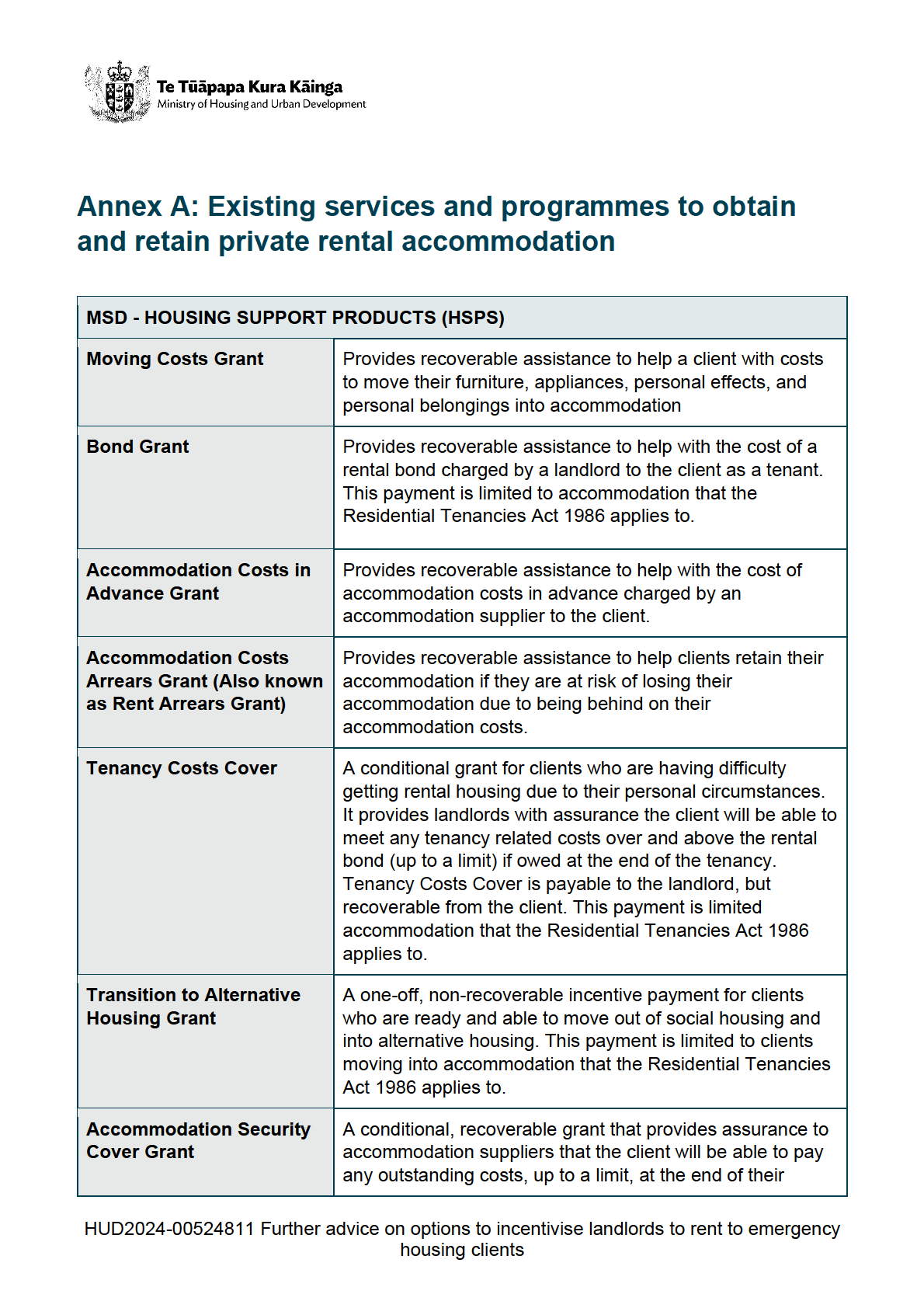
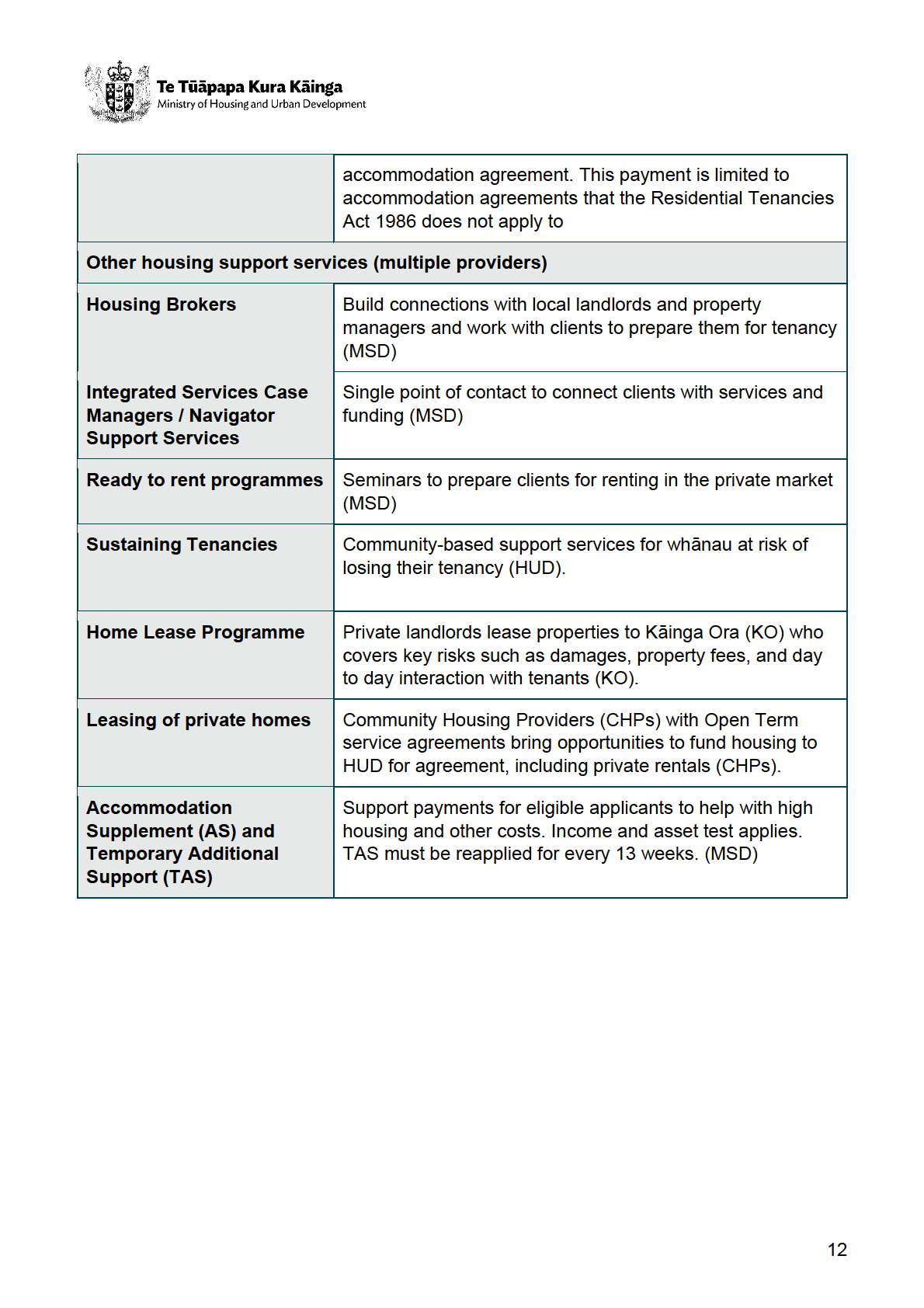
 Annex B: Key insights from stakeholder engagement on
options to incentive landlords to rent to EH clients
Annex B: Key insights from stakeholder engagement on
options to incentive landlords to rent to EH clients
•
The key incentive for landlords is to provide rent certainty. Guarantees and
reimbursement favoured as backstops rather than income redirection. Limitations with
Tenancy Cost Cover does not offset all potential loses.
•
Timely damage remediation is important. Essential for properties to be leased out
again. Existing supports are useful but potentially not timely enough to be
incentivising. More about restoration/compensation.
•
Support from landlords for better education about MSD housing products and
support services. Knowledge/name recognition of these provides confidence to take
MSD clients generally.
•
Incentive payments are part of investment decision-making already, but not a
good stand-alone option. Wouldn’t support the investor business model but could
shape behaviours to take on EH clients. Regarded as lower priority for an incentive.
•
A single point of contact for tenant issues provides considerable value to both
EH client tenant and landlords. Less interest (or possibly some confusion) in a
general helpline.
•
The benefits of head-leasing, especially property management, would suit some
investors well. The property manager would need to be good and insurance would
need to be addressed (but not necessarily by a government interventions).
13
 Annex C: Further information on an education campaign
promoting current housing support products and
services
Annex C: Further information on an education campaign
promoting current housing support products and
services
• During engagement with landlords, there was interest in products which MSD and HUD
already deliver. While some stakeholders know about HSPs and sustaining tenancies,
this knowledge is not known or, potentially, available to all relevant parties.
• Undertaking an education campaign to raise awareness about existing products and
services would be a valuable and cost-effective initiative to encourage landlords to rent to
people from EH.
• Promoting these supports may alleviate some of the concerns landlords have towards
people perceived as higher risk.
• This may not offer as direct an incentive as a monetary payment or changes to current
tools to make them more amenable to landlords. However, it is an initial, cost-effective
tool to enhance the system.
• An education campaign to promote current products and services could include:
a.
Communicating key messages through online channels (website news item,
email newsletter, social media pages)
b.
Sharing key messaging with key stakeholders, e.g. property management
sector groups and landlord/property investor groups, for them to share with their
networks (of private landlords and property owners).
c.
Identifying relationships at the national and local level that either need to be
developed or strengthened to support this work.
14
